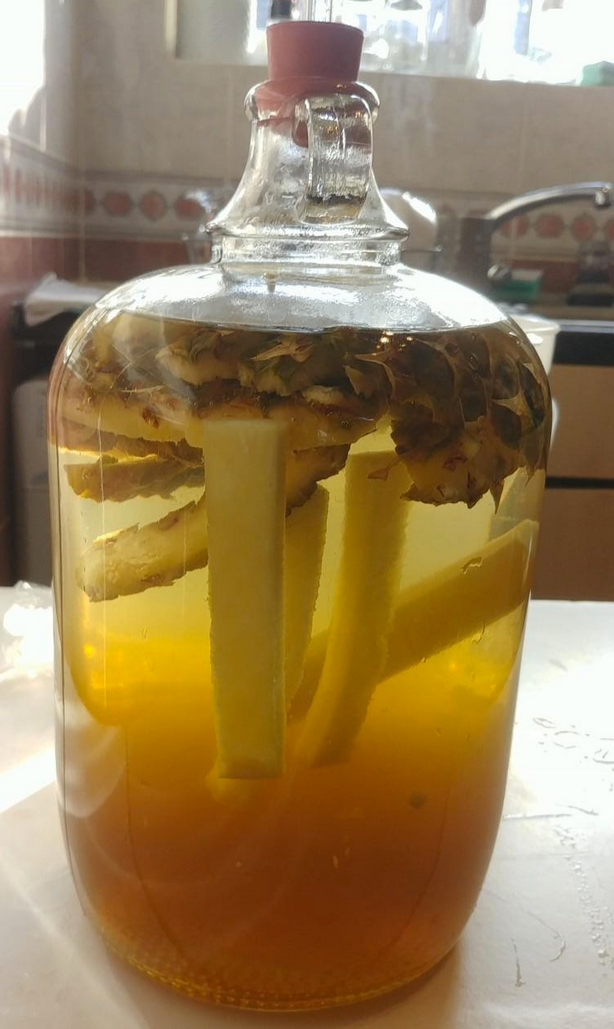Tepache
Hello guys, I wanted to share my thoughts and experience on brewing the honey Tepache. You can watch the video detailing step by step how to brew it @GosnellsMead
First, a brief history of Tepache:
Tepache is a traditional fermented drink from Mexico. The first evidence of Tepache brewing comes from the pre-columbian era (more than 400 years ago), the first brewers being the Nahua people. The word "Tepache" comes from the nahuatl word "tepiātl" that means "drink made out of corn", as Tepache was originally brewed from corn and a raw brown sugar called "piloncillo".
With the arrival of the Spaniards to America, Tepache brewing shifted from corn to other fruits (like guava, apples or pineapples)
Nowadays Tepache is still quite popular in Mexico and in other Mexican communities (I.E. South-western United States). It is more of a low ABV (around 1%), refreshing drink and you can buy it in restaurants, bars and even street vendors! (Sometimes in a plastic bag with a straw).

Due to its low abv, Tepache is considered a family drink for sunny days. But some Mexicans that like a bit more alcohol in their fermented drinks, don't hesitate to pour in a beer in their Tepache mug!
The recipe:
With this project I wanted to make a harmonious blend between mead and Tepache. For this, I substituted the "Piloncillo" sugar with honey. I used a bigger amount of honey than usual recipes to avoid getting the pineapple and spices flavour masking the honey profile (and to get a cheeky couple of extra ABV points as well).

I kept the rest of the recipe as traditional as I could, still using spices and wild yeast from the pineapple skin.
Honey Tepache recipe
3.4 L of fresh water
450g of honey
1 Big pineapple
6 cinnamon sticks (optional)
6 cloves (optional)

The brewing:
Home brewers caveat: I wanted to be sure that the yeast that fermented the honey Tepache was coming from the pineapple skin, so I did wash and sanitised my equipment before brewing. That's why I heated up the honey as well (honey has dormant wild yeast spores in it). Now, I don't believe this level of sanitisation is necessary to make Tepache, being a drink so popular and brewed in so many households and kitchens, I would think the majority of them do not take these many precautions and most of the time end up with a nice brew too. So I would recommend sanitising just as any other brew, but whatever you do with sanitisation, it is still paramount to brew with spotless clean equipment.
As we use the skin of the pineapple, I would recommend using organic fruit, as skins are the part of the fruit that gets dosed with pesticides and fertilizers. If you can’t find an organic pineapple, any will still work the same. Whatever the organic status of your fruit is, just give it a good wash under the sink (using just warm water and not soap) as we don’t want to be drinking dirt with our Tepache (even when this dirt tastes deliciously like pineapples and honey)
One of the good things about brewing this drink, is that it uses the bits of fruit that usually people throw away (skin and rind). So it’s a great way to use the leftovers after cutting a pineapple. You can even grab the leaves bit (the top slice) and put it on the ground to grow a pineapple plant. 0% waste!
Another thing to keep in mind in this brew is that you will have to check your fermenter daily in the lookout for mold. The pineapple bits will float and if we have any mold strain or weird bacteria inside of our fermenter, things might start growing on those bits. If you start seeing something weird growing on your fruit bits sadly there’s not much to do but to start from scratch (throw away the brew, give your equipment a good clean, sanitise and start all over).
Don’t try and savage part of your brew, as once these spores are visible, it means that the mold has already spread all over our Tepache and as you might already know, mold can cause severe allergic reactions, asthma and/or other serious diseases if ingested. Good cleaning and sanitising practices are the best tools a home brewer has to lower the likeness of these spores flourishing in/on our brew.

Conclusion
The finished product ended up being great. It was hard for me to determine when to serve it, as the more you ferment it, the pineapple flavour shines more and more but you also lose some honey character. So it’s a matter of finding the right balance for your palate.
The flavour: There are definitely floral notes coming through, with some honey sweetness at the beginning and ending in a dry/sour pineapple-y flavour. I also added a bit of lemon juice in the jug to give it a citrus punch at the end. Also, as the Tepache is still fermenting when we serve it, it will contain a moderate amount of CO2 bubbles in it, giving the drink a slight “fizz” or carbonation.
The aroma: is a bit funky, as most wild fermented drinks (if you have ever fermented pineapple before you would know what I mean).
Visually, it ended up being a cloudy, dark (ish) yellow-orange drink.
If you are an experienced home brewer, when you watch the video you will notice that I didn’t use a hydrometer, any sort of ph regulation or added any yeast nutrients. This was made on purpose, as I wanted to preserve the spontaneous nature of a brew like Tepache.

Refreshing!
Variations
There’s not a simple definition of what Tepache should be or contain. There are dozens of Tepache recipes all around Mexico with only 2 ingredients in common: pineapple skin and water.
Some popular variations that you can find around are:
- Adding pineapple juice as a sugar source
- Using different spices (like ginger)
- Using malted barley as sugar source
- Adding other fruits like guava or mango
- Pitching a known strain of yeast (instead of wild yeast)
I hope you enjoy brewing and drinking this recipe as much as I did. It really is a refreshing drink and I would recommend having it on a hot summer day.

